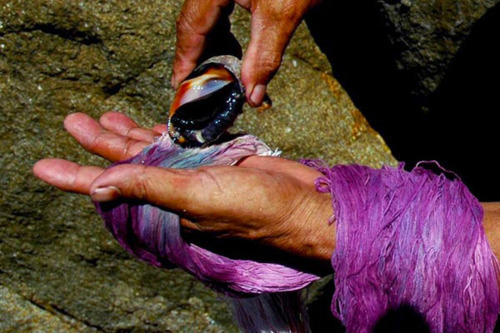Difference between revisions of "20. What was Tyrian dye and why was it important?"
Armcfarland (Talk | contribs) |
Armcfarland (Talk | contribs) |
||
| Line 5: | Line 5: | ||
-Tyrian Purple was first produced by the Ancient Phoenicians in the city of Tyre | -Tyrian Purple was first produced by the Ancient Phoenicians in the city of Tyre | ||
| − | -Tyrian Purple is named after the ancient Phoenician city of Tyre, where it was produced in about 1600 BC | + | -Tyrian Purple is named after the ancient Phoenician city of Tyre, where it was produced in about 1600 BC. |
| − | |||
-Tyrian Purple is produced by a fresh mucous secretion of a small sea snail called murex. The exact species is spiny dye-murex. | -Tyrian Purple is produced by a fresh mucous secretion of a small sea snail called murex. The exact species is spiny dye-murex. | ||
| Line 13: | Line 12: | ||
-Approximately 60,000 murex animals were required to make one pound of Tyrian Purple. | -Approximately 60,000 murex animals were required to make one pound of Tyrian Purple. | ||
| − | |||
-From a snail, the murex, the Phoenicians obtained a crimson dye called Tyrian Purple. This was so costly that only kings and wealthy nobles could afford garments dyed with it | -From a snail, the murex, the Phoenicians obtained a crimson dye called Tyrian Purple. This was so costly that only kings and wealthy nobles could afford garments dyed with it | ||
Revision as of 13:31, 14 April 2015
Tyrian Dye
-Also referred to as Tyrian purple
-Tyrian Purple was first produced by the Ancient Phoenicians in the city of Tyre
-Tyrian Purple is named after the ancient Phoenician city of Tyre, where it was produced in about 1600 BC.
-Tyrian Purple is produced by a fresh mucous secretion of a small sea snail called murex. The exact species is spiny dye-murex.
-Approximately 60,000 murex animals were required to make one pound of Tyrian Purple.
-From a snail, the murex, the Phoenicians obtained a crimson dye called Tyrian Purple. This was so costly that only kings and wealthy nobles could afford garments dyed with it
-This dye was greatly prized in antiquity because it did not fade, rather it became brighter and more intense with weathering and sunlight. purple was the color of royalty and the designator of status, important because it showed wealth
-The name “Phoenicia” come from the roots meaning “land of purple/red”.
-Tyrian dye acted as a source of economy since there is no evidence of other cultures producing dye; so Phoenicians traded the dye.

Ancient Origins Manual (104) http://www.penn.museum/sites/biomoleculararchaeology/?page_id=80 http://phoenicianresearch.weebly.com/the-snail-dye.html
Arabel McFarland